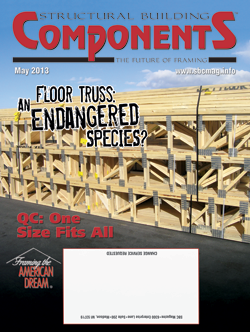Time for Us “Truss People” to Band Together
Time for Us “Truss People” to Band Together
A big thank you to everyone who participated in the February Open Quarterly Meeting (OQM). What an exciting time we had. While we tackle some challenging and important issues at these meetings, my favorite thing about an OQM is getting together with so many intelligent and passionate people in our industry. The latest OQM also spawned my idea for this article.
This issue of SBC Magazine focuses on engineering, design and testing of components, and the timing couldn't be more perfect. I recently had the opportunity to exhibit at a local home builders show. Not far from my table was a booth for a local independent building inspection group that several municipalities contract with to perform jobsite inspections. Being a little nosy, I decided to walk over and strike up a conversation. To my surprise, none of them had a copy of the new Southern Pine span tables or design value charts. I immediately emailed a copy to their smart phones. They were very appreciative and even agreed with me that contractors who use conventional framing methods would have to start complying with these new charts by June 1, or better yet, use components. It blew me away that the conversation went so well. Finally, a group of hard-nosed inspectors were on our side for a change! But wait, it was only day one of the show.
The very next day, I learned that these same inspectors were telling builders not to worry about the new design values and span charts in conventional framing. As an industry, we know that, from NAHB’s perspective, the ALSC/SPIB Southern Pine design value effective date of June 1, is effectively optional until the local building department enforces those values, and it seemed that same message had made it to this show. According to one source, the inspectors had a meeting with other building officials and members of the home builders association. Apparently, the inspectors said that these changes only affect the "truss people," and new design values would not be enforced for builders and homeowners using conventional framing until the values are adopted into the building code. What a morale killer. The very issue we have been discussing in SBCA meetings was happening right before my eyes. If we don't create a united front now, I'm afraid that components and all of us "truss people" will have a huge disadvantage when compared (unfairly) to conventional framing methods.
Now is the time for those of us who are passionate about our industry to fight back. We need to band together and provide the member input and funding to move forward with testing that demonstrates the predictability, quality and science behind the benefits of components. After witnessing what happened at this home builders show, it appears that we are still in survival mode, not just in our own businesses but in our very own industry. We need to take the reins and work hard to get SBCA in the position to conduct the testing that shows structural building components result in a safer, more reliable, better quality, and more affordable structure. If we prove that components are the future of framing, we won't have to rely on outside sources to behave fairly.
Our research center, SBC Research Institute (SBCRI), was built for this very purpose—to allow the industry to test and provide solid evidence on the benefits of component construction. It is our tool to use for instances just like this. SBCRI is sitting there waiting for us to create a better industry for each and every one of us.
I encourage you to stay involved in SBCA in the coming months. Your support, input and involvement is needed for our industry's success. With regards to testing, I truly believe that it will result in the next big revolution in our industry. Now is the time to be proactive and use the tools that we have in front of us.

